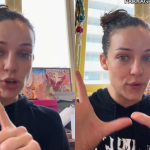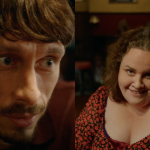
Speak to literally anybody in Sydney or Melbourne who either owns a house, wants to own a house, or is renting a house, and you best prepare for entering the battlefield: negotiating a conversation about the ‘Housing Bubble’, a shiny real estate anomaly, has dramatically usurped “the weather” as our number one preferred topic of small talk.
It can be painful. And it also consistently has you like:

Real estate is a fickle thing to navigate at the best of times, let alone when everybody wants to shout their opinion, loudly, in your face. Given the escalating hype surrounding the crisis, you’d definitely be forgiven for thinking that the “housing bubble” was an analogy for the skies opening up to the gates of Valhalla, prompting a veritable, and chrome, apocalypse.
The whole thing raises a lot of questions. Will the housing bubble pop? Are we even in a housing bubble? A bubble sounds sweet and squishy and protective, why is everyone so terrified? We hear you. We got this.
Sing me the basics. Housing Bubble – qué?
Look. The thing about the term ‘housing bubble’ is that it hasn’t really been “officially” defined. Journalists, academics, economists, banks, and your parents all have their take on it, each with a slightly different flavour. Which is why it makes the whole thing so damn slippery. But in a nutshell, a housing bubble presents itself when housing prices rise, off the back of demand outrunning supply. ie. too many buyers, not enough vendors.
Before we get too deep, Pedestrian has enlisted the help from certified legend Eliza Owen, Market Analyst at onthehouse.com.au, whose knowledge on this issue well and truly outshines ours.
She tells us, that beyond an increase in prices, and buyers partaking in “speculative investment” (when you buy up, thinking your purchase will deliver high returns), bubbles also come down to rapid growth: “Bubbles are characterised by rapid growth. According to Onthehouse data, the median value house in Sydney increased $123,000 in one year, between April 2014 and April 2015,” Eliza says.
BUT! We can only start labelling a price trend a “bubble” when the bubble “pops” – or, when—like all good bangers—something (the price) drops.

If there’s no burst, you haven’t got a bubble on your hands -you’ve just got a depressing trend of rising prices. RIP, you.
So are Sydney and Melbourne *actually* in a housing bubble right now?
Seeing as prices in Sydney and Melbourne aren’t dropping at the moment, the so-called “bubble” hasn’t actually popped. So we can’t definitively say whether the property market is ensconced in a floating, heinously expensive—but fleeting—reverie or not. You can only label it in hindsight, which is the critical buzzkill of this entire debate. But many are hedging their bets on “duh” as the classification of the “bubble” right now. What we do know is that housing prices in Australia are on the rise.
The increase in prices is leading some to believe that Australia’s real estate market isn’t in a bubble at all – just a big ole Boom that may not drop anytime soon. In a report published this week by HSBC’s chief economist Paul Bloxham, Sydney’s housing market is labelled as experiencing “an exuberance that is worrisome.”
Whether you label the market as a Bubble, a Boom, or nothing – pretty much everyone can agree: it’s probably worth being a bit worried about.
So, it’s yet to be *officially* seen whether or not Jake Gyllenhaal‘s classic 2001 film, Bubble Boy, is indeed a metaphor for the current real estate market.

Okay. But when will we know if it’s a bubble, dammit?
Not until we see prices drop. Keep up. At the moment, Sydney and Melbourne are just like Sisyphus pushing up that bitch of a rock to the top of that damn hill. He’ll get to the peak soon, fall back to the bottom, and it’ll start all over again.
So how bad is the Sydney and Melbourne market at the moment? On a scale of “definitely” to “NOPE” how likely is it that I’ll be able to own my own sweet digs?
Decide to earn good money, Joe Hockey says, and you’ll turn that “NOPE” into a “definitely” in no time.
But it’s obviously a lot more complicated than that.
We can’t tell if you are/aren’t rolling in the benjamins. But we do know that housing prices in Sydney and Melbourne are truly a sight to behold. According to Bloxham’s report, housing prices in Sydney have risen 39% in the last three years; housing prices in Melbourne have risen 22% in the last three years. The trend nationally is far less stark: prices are up around 10% in the last three years in other areas. City-dwellers in QLD, SA, TAS, NT, ACT, WA: you’ve probably got a lot less to worry about than Sydneysiders and Melbournites.
You have permission to be smug.

So in terms of the cost of houses in Sydney and Melbourne, though, we should be thinking in terms of the M E D I A N price. Average prices are misleading – Packer’s portfolio of mansions, and apartments the size of closets provide for some significant outliers, there. In Sydney, Eliza tells me that Onthehouse data pitted the median house value at $945,000 in April 2015.
So when you take into account that many first-home-buyers are encouraged to put a deposit of 5-20% on a house to qualify for a loan, and those first-home-buyers often have HECS debts to think about, buying a house in your twenties seems to be more and more of a fantasy by the day.
I mean, $900,000 might as well be a bajillion dollars, tbh.
Right? It’s so much freaking money.
So you’re saying I should move to Canberra?
Pls. We would never implore somebody to move to Canberra. Nice place and all. But Canberra isn’t looking too peachy either.
WELL. I’ll just hold off until the bubble pops, and prices fall. I’ll buy up when chic houses are being spruiked like vacuum cleaners at Godfrey’s. I’VE GOT THIS.
Nope. Probably not the best idea. In April, real estate mogul John McGrath wrote for Switzer, saying a Mexican standoff with the property market isn’t smart buying. Do not meet the property market at dawn and draw your pistol, waiting for it to falter before you do: McGarth claims that the “burst” of a bubble would be too gradual to be of any discernible, immediate benefit. In major cities like Sydney and Melbourne, prices don’t go down often, and when they do, that period tends to be cruelly brief.
So in this situation, prices won’t plummet, they’ll just slowly ease, John McGrath says.
“The most you’ll see is a slight softening, reflective of less demand, with small price growth in some months and small losses in others, citywide.”
And besides. We don’t even know when a drop could happen. That kind of gamble is risky AF – if prices don’t drop, and you suddenly need to buy up, for whatever reason: you would have wasted time and money sitting back, playing the waiting game. And you know how much the waiting game sucks.

Say the bubble does pop, what will happen? The GFC was pretty much borne from a housing crisis. Will this thing have global reach?
Settle down, m8. The housing crisis in the US was a very different, and far more malicious, brand of beast. Comparing the two would be inappropriate: in the US, a lack of regulation led to banks approving loans to pretty much anybody. Offering up loans without ANY downpayment wasn’t unusual. People were borrowing like crazy, and couldn’t afford to pay banks back. And so the subprime mortgage crisis, trickling into the GFC, was born.
Sydney’s real estate pickle doesn’t hold anywhere near as much influence. There will be no feature-length film, led by Kevin Spacey, dramatically recreating the final moments of the housing bubble on the brink of a slow-motion shatter. This is no Margin Call; this will be far more boring.
So how will the effects of the bubble bursting manifest?
If the “bubble” does pop, and housing prices do drop, the consequences can be pretty brutal on the economy. Jobs in construction and housing may suffer, as supply gradually outweighs demand. On a small scale, some towns can become so unaffordable, businesses and families flee – making certain micro-economies suffer. We’ve seen this happen in mining towns before.
Eliza Owen tells us that the hefty loans taken out during the bubble could become a strain: “If the bubble pops, houses and units will become much cheaper, but many will still owe the banks hundreds of thousands of dollars. As long as they can service this debt through personal income and rental income, then they will not have to sell the properties and default on their loans.”
Personally, we really want the bubble to POP. Just so we can see if it was worth all the hype, and all the op-eds.

So What causes a housing bubble? Who can I blame? It’s Tony Abbott, isn’t it. I bet it’s Tone.
It’d be so easy, and so sweet to heap the blame it ALL on the Government. But while we can blame Joe Hockey for being out of touch with average Australians after this week’s comments, he—and the rest of the government and regulatory bodies—aren’t single-handedly responsible.
One big factor in this is the lowering of interest rates – making loans, in theory, more affordable. Another factor is investors flooding the landscape: in an op-ed by Waleed Aly for the Sydney Morning Herald today, the amount of properties currently without occupants is said to be greater than HALF of the market.
While the government can’t just tell cashed-up investors to stop buying up the real estate market and inflating prices, they can provide further regulation on negative gearing and capital gains taxes, making the subsequent tax loopholes far less sweet, and opening up the market for buyers looking for a home – not necessarily an investment.
So, innocent buyers wanting to settle down aren’t to blame. We are all but the Matt Damon to the omnipresent shadow of real estate’s Robin Williams.

You lost me at “negative gearing”.
Stay with us on this one. Let’s put negative gearing this way: Mister X buys the house across the street. He wants to rent the property out. It costs $440,000. He lays down a 10% deposit, and borrows $400 K from the bank.
The interest on his loan for the year—let’s say—is around $30,000. But he only charges $400 a week for rent, making only $20,800 that year.
So when you look at Mister X, he’s in trouble: he’s spent $30,000 on interest alone, and only made $20,800 back. He’s negatively gearing. The ATO see Mister X’s predicament, and let’s him take the gap between money spent and money earned on the property off of his taxable income. Ka-ching.
This process starts to leave a bad taste when you realise that Mister X is actually a lot wealthier than you thought, and he *could* be using negative gearing as a cheeky tax break from his enormous income. All while the value of the property increases anyway, subsequently skewing his “losses”. The Guardian called negative gearing, “A legal tax rort for rich investors.”
There’s your problem. Labor and The Greens are both reportedly planning to lobby for tougher rules on negative gearing – reforms that could potentially save the Government $29 billion a year.
I still don’t get it. My parents were able to afford a house at my age. Seriously, will I ever be able to afford to buy in Sydney and Melbourne?
We’ll give you two options.
It really depends if you want –
 OR
OR 
The Truth: Sydney and Melbourne housing prices are going to be out of reach for a lot of people. Hockey *kind of* had a point – you need a really, really, well paying job to afford to buy a house. If you thought that tidbit was akin to rocket science, you’ve got more problems than one, ‘fraid to say.
Even if you save up 10% of a median house in Sydney (say, $90,000) it’s not like you can just pop the champagne, celebrating your ticket to real estate forevermore. First off, you can’t just sit back: your income has to be stable to make repayments every month. You also have to consider the price of:
– Stamp duty
– Residence upkeep
– Strata, body corporate or council fees
When you think about people who bought in Sydney back in the 80’s, median housing prices sat at (roughly) around $350,000 – when you convert to the real 2014 cash equivalent. The median house price between your parents and you has therefore just about TRIPLED. The average income, it turns out, definitely has not. So unless your boss decides to start paying you threefold, yeah – the median house is a lot more out of reach for us than it was for our parents.
Eliza Owen tells me that it all depends on where exactly you’re talking about – in Melbourne, too – where prices are noticeably lower.
“I think it [Gen Y buying houses] is much more likely in the outer suburbs of Melbourne, perhaps not in the inner city though. People talk about a housing affordability crisis in Melbourne, but Melbourne house values are approximately 30 per cent lower than houses in Sydney. In the last year from April 2015, Melbourne house values increased 5 per cent. In Sydney they increased over 15 per cent. So you can see it’s a lot harder to play catch up with the growth in Sydney.”
If you want to know Lionel Hutz’ option B, “The Truth!” then: sure, you can afford to buy a house. Go live your dreams.
I’m sick of you. What’s everyone else saying about it.
Waleed Aly is pretty fed up with the crisis, and the fact that we’re going to see a whole host of young people forced out of the market.
We’re now witnessing a generation of Australians on the verge of realising they might never own a home. We’ve never seen that before. And with it we’re witnessing the slow death of an idea: that the free-marketeer’s great loves – investment and capital – do not automatically improve everyone’s lot. That’s why criticisms of negative gearing are working their way into mainstream conversation in a way unthinkable only a year ago.”
“What a lot of white, wealthy, middle-aged men fail to understand is that most other ethnicities, age groups and gender identities face nuanced structural and societal barriers which prevent them moving into higher paid positions. Australia currently has an official unemployment rate of 6.2 per cent, which is above the ten year average of 5.1 per cent. Casualisation of the workforce has doubled since the 1980s to represent approximately 30 per cent of the work force in 2015. The nature of work is changing. Technology has evolved such that one of the only competitive advantages we are likely to have left in the future is analytical thinking skills and imagination. Yet the Government has no initiatives to enrich tertiary education. Go figure.”
“What Hockey’s many critics seem to have forgotten is the “best” suburbs have always been beyond the reach of all but the highest-earning Australians – this is the way economic supply and demand works. You could have bought homes in some of today’s most “prestige” suburbs for what now seems like peanuts because most people in the ’80s worked full time for half or quarter of a peanut, annually.”
The author gives us four pieces of advice for buying a house in Sydney when you’re 23: mooch off your parents until you can afford a downpayment, “get a well paying job“, don’t “actually buy a house“, and make that non-house in Canberra, not Sydney or Melbourne.

I should probably just rent instead, shouldn’t I?
You’ve probably had worse ideas. Renting can have its downs, and renting prices are still steep, but it doesn’t actually suck: a lack of commitment to a place and an “investment” certainly eases stress levels. Plus, you’ll probably benefit. You might not be able to afford to pay the mortgage repayments off a $1million property in Sydney, but you might be able to afford its weekly rent.
‘Round here, something struck a pretty big chord during a screening of ‘99 Homes’ at the Sydney Film Festival last week. The film is based around the subprime mortgage crisis in the US, where the absolutely flawless, do-no-wrong Michael Shannon passionately insists: “Do not. Get emotional. About real estate.”
Should we feel so deeply hurt, victimised even, that we can’t actually afford to buy our “dream home”? Sure, having a permanent nest (and forging memories within it) is gratifying, but why do some of us take home ownership so personally, while other cities like Berlin see a far greater portion of its residents happily renting?




